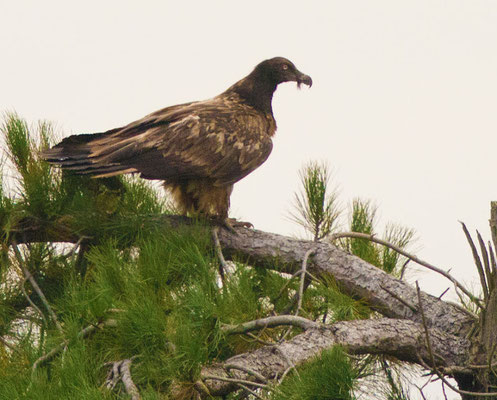
The Bearded Vulture “Vigo” surprised us once again! After leaving Derbyshire and heading south, the vulture took a northern turn and remained in the UK instead of returning back to its mountainous habitats in the Alps or the Pyrenees.
Current whereabouts of “Vigo”
After nearly three months in the Peak District, Vigo left Crowden on Friday, 18 September, and was spotted the following day in Lathkill Dale and then near Leicester on Sunday, flying high and travelling south-east! On Monday, 21 September, Vigo was seen to the west of Oxford, before being spotted one week later in Norfolk, 225 km north-east from the last confirmed sighting.
Yesterday, on 8 October, Vigo was back on the radar of birders after the bird was sighted near Cowbit, Lincolnshire. As expected, many birders and nature-enthusiasts flocked to the area to get a glimpse of this magnificent vulture, which marks the second confirmed record of the species in the UK in recent years. Although the excitement is understandable, and Vigo appears to be quite relaxed despite all of the attention from people and corvids alike, it is important to keep a safe distance to avoid disturbing the bird from its roost sites. It is also especially important that the vulture is left to feed undisturbed, as it was observed to do this morning. As we would like all members of the public to enjoy the presence of this Bearded Vulture in their local area, we kindly ask people looking for the bird to park their cars sensibly and keep to public access areas.

Field mission to check up on the bird
Yesterday, we here at the Vulture Conservation Foundation were informed that the bird was grounded in bad weather, which did not seem like a good sign. So, our Research Officer, Louis Phipps, who is based in the UK, drove 1.5 hours to observe Vigo to determine if anything was wrong.
After observing the vulture, exploring the surroundings and speaking to some local farmers, he verified that although the area was not ideal due to the flat landscape, relatively high density of power lines and roads, and the presence of wind turbines, good numbers of deer and hares should provide potential sources of food. This was confirmed on Friday when the vulture was seen eating a hare or rabbit in the morning. Also, on Thursday morning local birder and photographer Will Bowell observed the vulture regurgitating a pellet and eating some of it. It is normal for Bearded Vultures to investigate pellets again to see if there is any food left, as there are usually small pieces of bones remaining. Encouragingly, this indicated that Vigo had eaten relatively recently.
Having spent most of the morning on the ground in a ploughed field close to a drainage ditch, Vigo then flew to the edge of Cowbit village, where it perched on a tree close to a main road before moving to another larger tree on the edge of a field. Although it is unusual for Bearded Vultures to perch so close to human activity, the apparent lack of suitable roost sites might explain this behaviour.
It was later reported that Vigo was eating leaves from this roost tree, although, being curious birds, picking and nibbling at non-food items is relatively normal for the species.
Thankfully, the bird was flying well, although there were always lots of corvids paying it close attention. This was perhaps not helped by the fact that it chose to roost in an old rook nest! Combined with the fact that the bird was seen defecating and regurgitating on Thursday, and then eating on Friday, there does not seem to be a need to intervene at this stage.
Please report any observations of Vigo to ibm@4vultures.org. The VCF together with many partners are responsible for the reintroduction of the species in the Alps and in other regions, and manage the monitoring of Bearded Vultures across much of its European distribution range.
Genetic Analysis underway to reveal the Bearded Vulture’s identity

As Vigo does not have any ring, tag or markings, the only way to tell its origin is through genetic analysis with a blood sample or with feathers. The good news is that we received some feathers! David Ball found and retrieved two small feathers in an area where Vigo had been seen regularly in the Crowden area of Derbyshire and got in contact with us. Our colleague, Franziska Lörcher, who is a Bearded Vulture expert, confirmed that the feathers originate from this species and it seems that we will have the results from the genetic analysis soon! Revealing the origin and identity of the bird is possible because of the extensive genetic data gathered as part of the extensive monitoring done by our partners in the Alps and coordinated by the Stiftung Pro Bartgeier. Thanks to David for collecting the feathers and contacting us, and for keeping an eye on Vigo throughout the summer!
We have prepared several insightful articles and important statements regarding the Bearded Vulture in the UK. You can read them to find out more below:
- Second observation of a Bearded Vulture in the UK (first sightings + why the species wander)
- Second record of Bearded Vulture in the UK — why did it travel to the UK, where did it come from and will it return home?
- Vulture Conservation Foundation’s statement on ‘repatriation’ of the Bearded Vulture in the UK
- Bearded Vulture “Vigo” left Derbyshire + why there is no need of intervention
Make sure you follow the VCF on Facebook and Twitter to be notified when we have the results!





